Mary Shannon
Portland, Oregon, United States
Introduction

Selection of 6 prints from a 27 photographic series
Silver gelatin prints – 8 x 10”
© Joyce Cutler-Shaw
How do we as clinicians, caregivers, and fellow human beings talk about death and dying in our culture, or perhaps more precisely, how do we not talk about it? Many avoid the topic out of fear, denial, or discomfort, creating silent narratives that torment, isolate, and separate at a time when connection with others is needed the most. How can we begin to break this silence? How can we live and die out loud while building compassion, connection, and understanding?
By crossing the traditional boundaries of words with color, shape, line, and texture, contemporary artists Joyce Cutler-Shaw and Ricardo Mazal are helping to shape our post-modern view and cultural construct of not only what it means to make the natural transition from life to death, but also what it may look like. The power of an image to make the invisible visible, to re-define, encourage, and empower us to think about death differently, and then to talk about it differently, is how individual and cultural silences are banished; it is how a strong, collective voice is born.
Beyond words: Visual representation
The complex and intimate relationship between the verbal and visual, the body’s two distinct modes of information gathering and communication, have historically “often been in contest, even open conflict . . . ” (Morley 2003, 14).
In our current era of information overload we are bombarded with texts and images, easily forgetting that before words, humans used to rely solely on pictures. In prehistoric times, men used pictographs—line drawings etched into the walls of caves—to make contact with one another. It was the first link in an emerging process of communication that said, “I am here. Recognize my presence.” It endowed its creator with a certain kind of immortality since some images extended beyond the human’s life span.
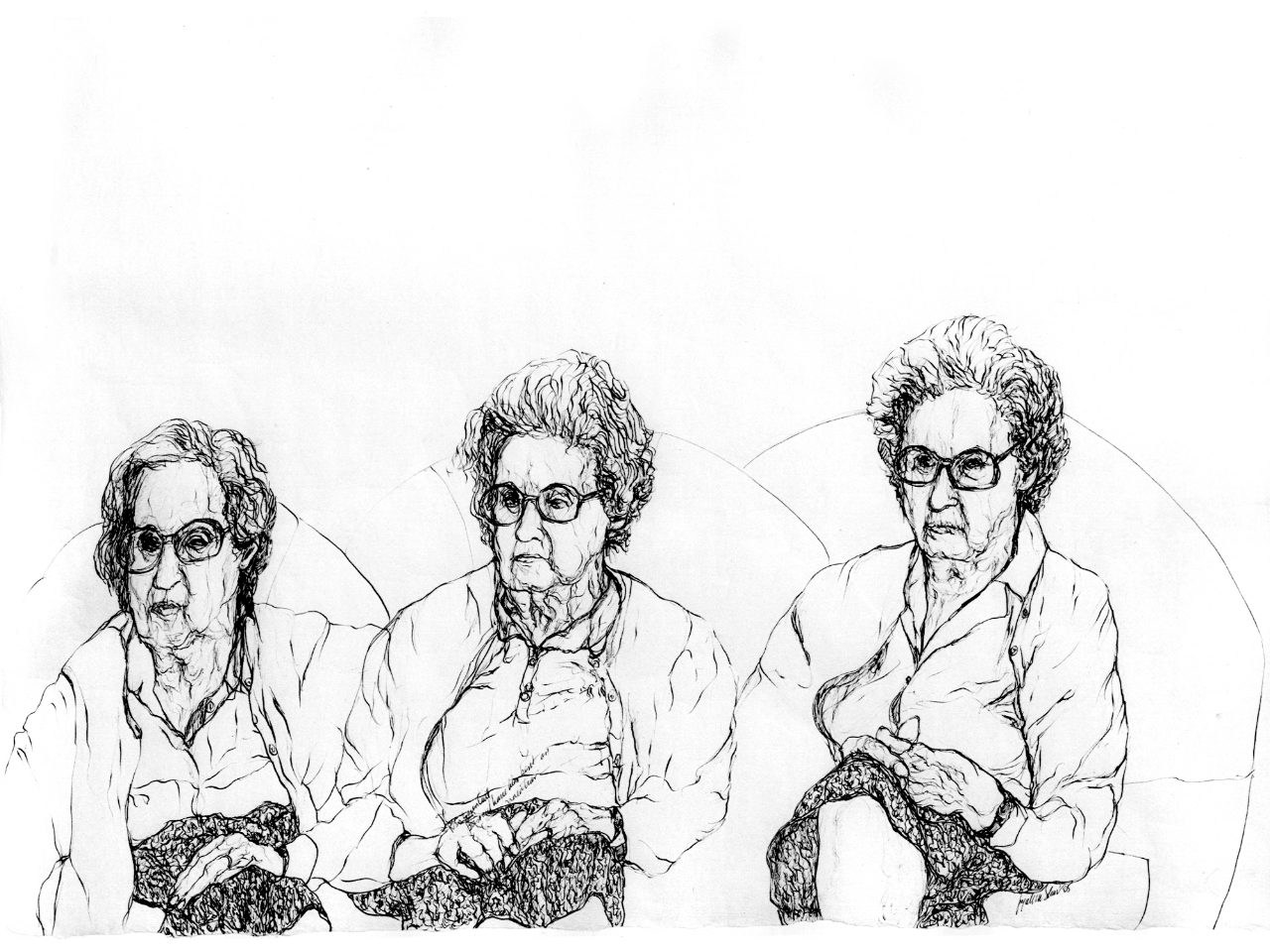
Ink on Japanese handmade paper 23 ½” x 33 ½”
© Joyce Cutler-Shaw
But what exactly goes into visual representation? What are the particularities of influence affecting the one who is doing the representing? Author Susan Sontag reminds us that all imagery “represents the view of someone” (Sontag 2003, 31), and yet that view may change throughout the creative process, through the inter-subjective dialogue it engenders between the maker and the self and between the maker and the viewer. The process of making art—of objectifying and distancing oneself from the experience one is relaying—is a release of sorts. Once the internal landscape is given external form, a new relationship to the experience can emerge. No longer is the experience imbedded within the artist’s psychic/bodily space, for the objectification allows a perceptual shift in both cognition and affect to occur. The maker can now “see” what was once hidden, and begin to see it anew.
When creating or viewing a piece of art, it is important to remember that the image does not exist solely on its own, for it is “bounded by a space-time of experience that sets it off from the mundane world. This does not imply a separation from the world . . . but the fabrication of a way of being in relation to things, so that they are imbued with meanings that previously did not belong to them” (Radley 2009, 189). And it is this possibility for new meaning that sets the act of creating and witnessing visual representations of death and dying apart from other forms of communication.
Every “culture must establish a particular relationship to pain and death . . . a grammar of pain itself . . . both external and internal to the body” (Bennett 2005, 49-50), for it is only then that meaning can be assigned and a greater understanding of the experience can be achieved. But because grief and mourning are more diffuse and unruly than other life experiences, it is beset with an uncertain temporality whose course “engages a much slower process of perception, in which the transformation of the object is itself gradually apprehended rather than instantly recognized” (Bennett 2005, 61).
Art provides a safe space with which to re-imagine and re-configure the death and dying experience, making it a wholly unique endeavor that accepts inner and outer worlds equally and manifests them with continuity. The discursive space created by art provides the maker and the viewer with an opening, an opportunity to co-construct a broader vision that may not have been possible through any other interaction. Through this melding of interiority and exteriority in the form of visual representation, a depth of understanding and ordering of one’s experience occurs, often at a subliminal, unrecognizable level at first, but it is here, at the nexus of conscious and unconscious perception, where the important work of psychic integration of the experience begins.
Transition from life to death by Joyce Cutler-Shaw
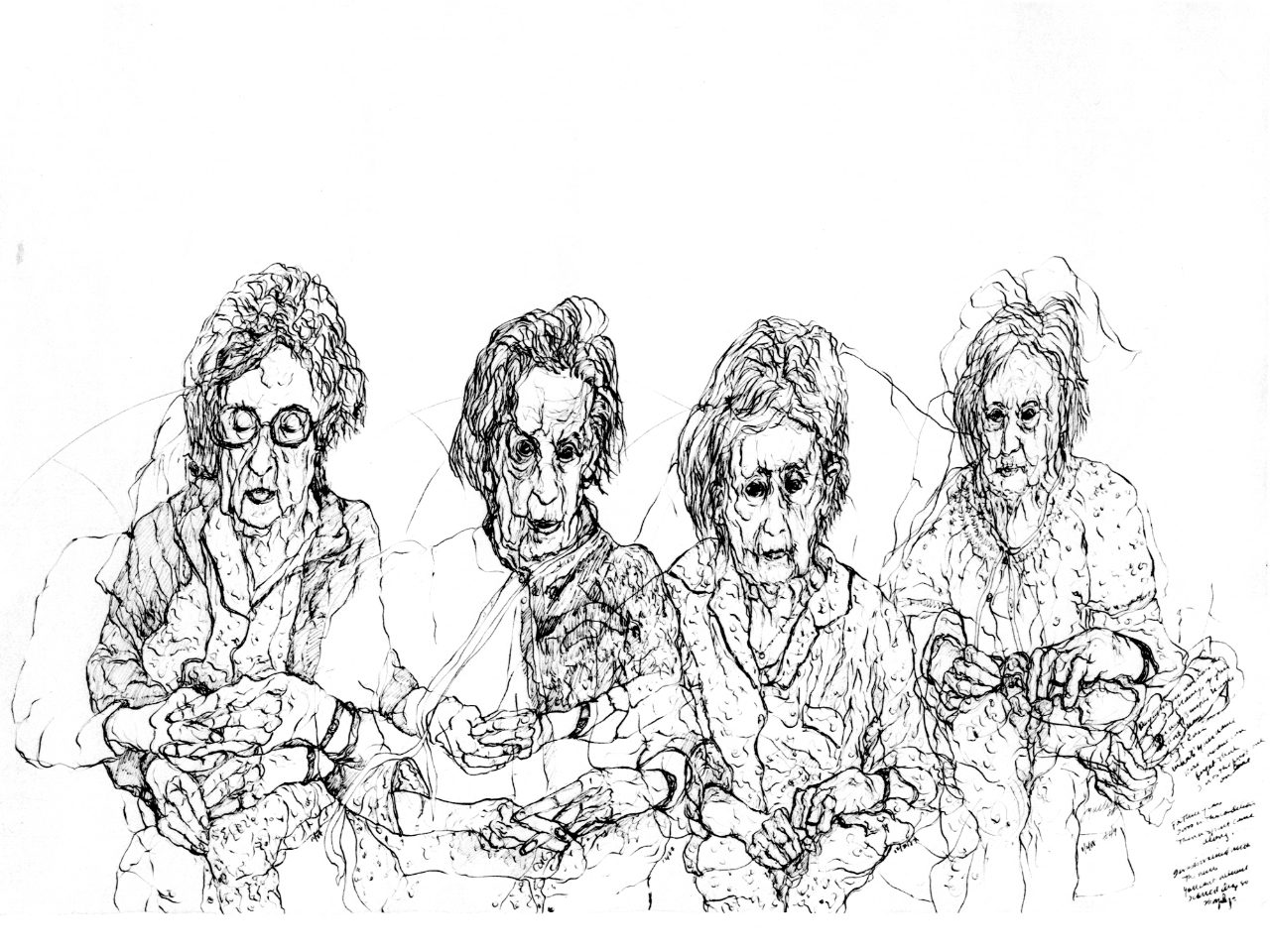
Ink on Japanese handmade paper 23 ½” x 33 ½”
© Joyce Cutler-Shaw

Ink on Japanese handmade paper 23 ½” x 33 ½”
© Joyce Cutler-Shaw
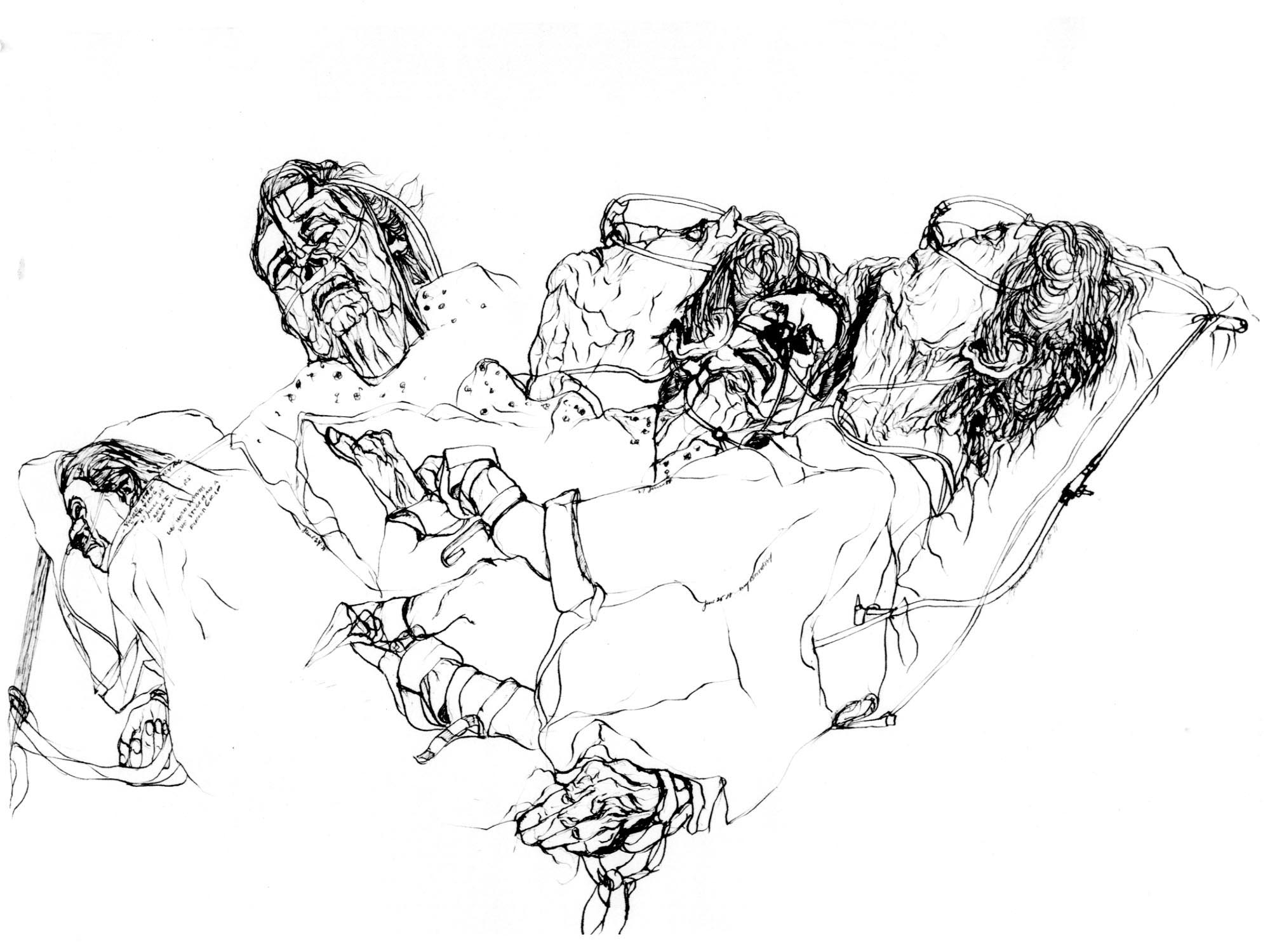
Ink on Japanese handmade paper 23 ½” x 33 ½”
© Joyce Cutler-Shaw
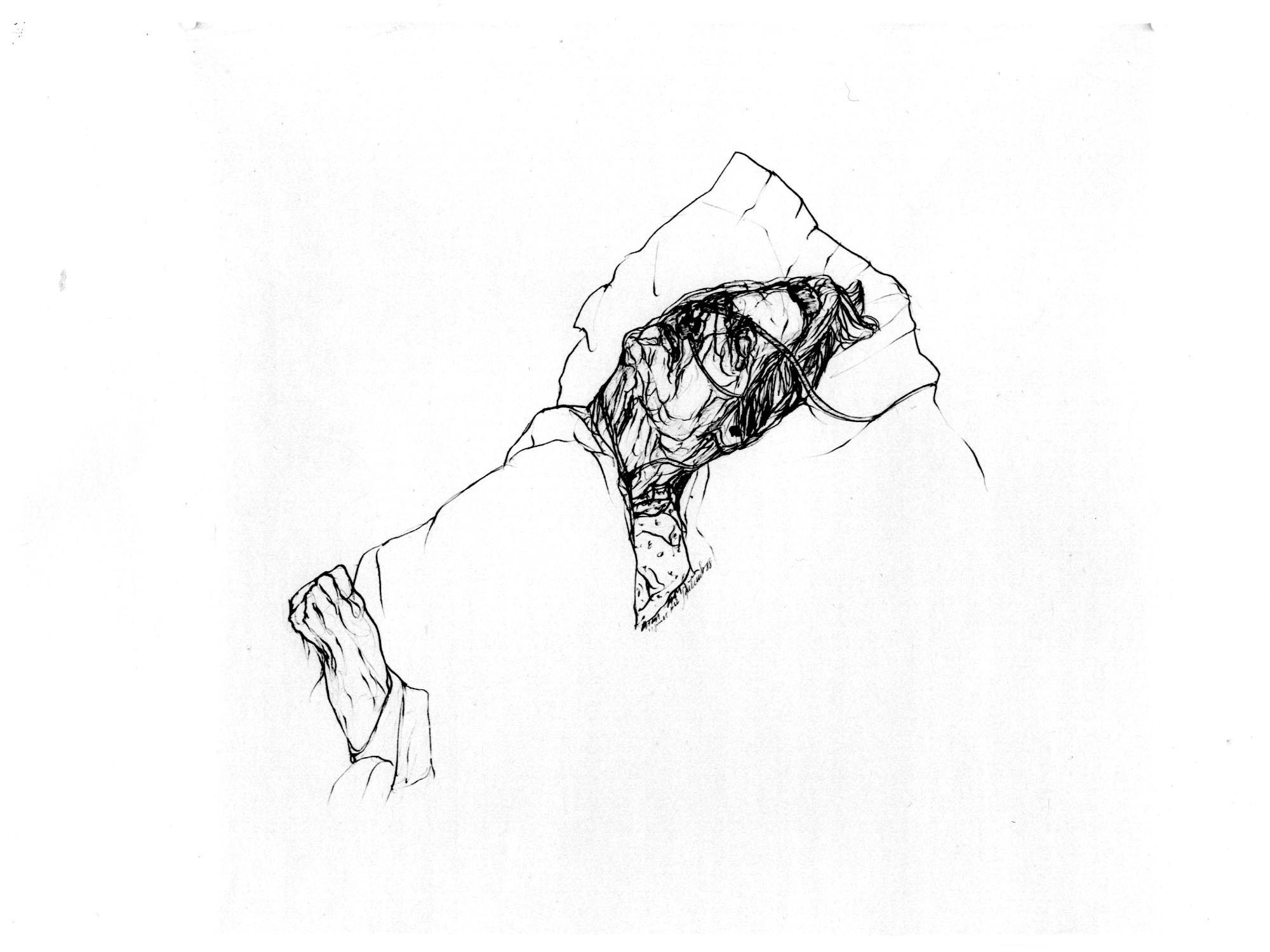
Ink on Japanese handmade paper 23 ½” x 33 ½”
© Joyce Cutler-Shaw
Through the ages artists have utilized the process of visual representation to confront strong emotions. For Joyce Cutler-Shaw it began during a photographic study she was doing of her next-door neighbor, Eddy.
“‘It’s too much work to live,’ he suddenly told her one day, and he let go. His hand dropped. His head dropped. . . . What was left was suddenly leaden. His skewered mouth, contracting, even before my eyes, was sculpture. He had become sculpture” (Cutler-Shaw 2010).
When Cutler-Shaw speaks of Eddy, she does so through the lens of a keen observer. “He was under five feet tall, less than ninety pounds, and for many years, in a state of chronic heart failure. He was a very quiet man. I was captivated by his hands, claw-like, and skeletal. They spoke in a language of gesture, as a conversation in an alphabet of bones” (Cutler-Shaw 2010).
Cutler-Shaw then witnessed the slow death of Eddy’s wife, Rose, whose portrait she drew every week for five years, resulting in more than 100 multiple image drawings in pen and ink. “Rose did her dying ever so slowly, in a leisurely retreat. She regressed in small, barely visible strokes, wandering through her memories, confessing her secrets, one by one.” According to Cutler-Shaw, “How we depict the body . . . and interpret the body . . . and behave toward the body . . . reveals the way we see and understand ourselves.”
Today, Cutler-Shaw continues to “approach the body as a matrix of the human condition, and the study of its territory as a geography” (Cutler-Shaw 2010).
Ricardo Mazal’s depictions of burial practices

Palenque, Mexico
Photograph by Javier Hinojosa
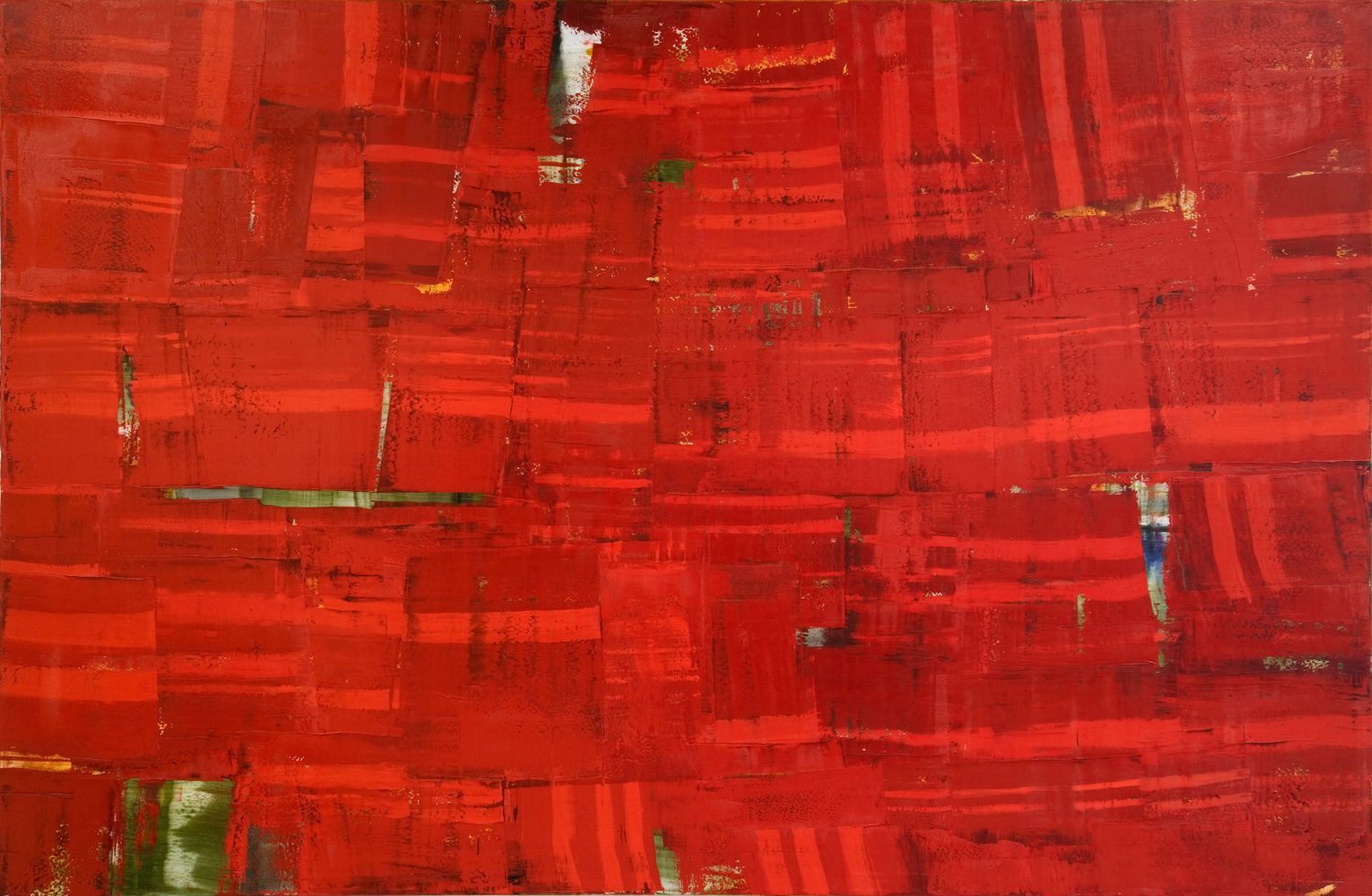
Oil on linen – 98.5″ x 150″
© Ricardo Mazal
Artist Ricardo Mazal’s study of mortality was originally inspired by the death of his mother at age fifty-nine. He has since traveled the world to ancient burial grounds examining the cultural rituals of death and dying, with the goal of producing a multi-cultural trilogy on burial practices. Part I of this trilogy, The Red Queen, was based upon the discovery of an ancient Mayan tomb in Mexico dating back to AD 600, where a limestone sarcophagus held the “mummified remains of a woman cloaked in a rich, red pigment called cinnabar,” the same color Mazal often used in his own work, and depicted in the photograph below.
In 2003, he traveled to the foothills of the Eastern Chiapas mountain range to do research and photograph the burial site. Transferring photographic images of the site to his computer to produce digital sketches, he studied their shape and space, their interplay of light and dark, until he was ready to begin transferring these concepts to the canvas. His goal was to create a “deep sense of space, time, and movement.” Two of his finished pieces were the exact dimensions of the Red Queen’s burial chamber (98.5 x 150 inches), and he used the same measurement to create an installation for an exhibition at the Museum of Anthropology in Mexico City.
In May, 2005, Mazal was suddenly faced with his own mortality when he and his family were the victims of a near-fatal car accident. Though no one was seriously injured, he looks upon that day as “the strongest experience I’d had in my life, and it forced me to reflect on the themes of my work. I now understood that they were not about death, but really the celebration of life” (Bamsey 2009).
Part II of his trilogy, Odenwald 1152, began in 2007 while visiting a friend in Germany, who took him to a wooded escape called Friedwald (Peace Forest). As they walked the land, Mazal noticed that many of the trees had been tagged with circular plaques, each inscribed with different numbers and the letters “OD” (short for the Odenwald region in Germany). The friend explained that the forest was designated as a place where families could lease the rights to a tree for 99 years and inter a loved one’s cremated remains beneath its limbs, where it was believed the loved one would coexist with the roots and live on in the woodland in eternal peace. Mazal knew this would have to be his next project.
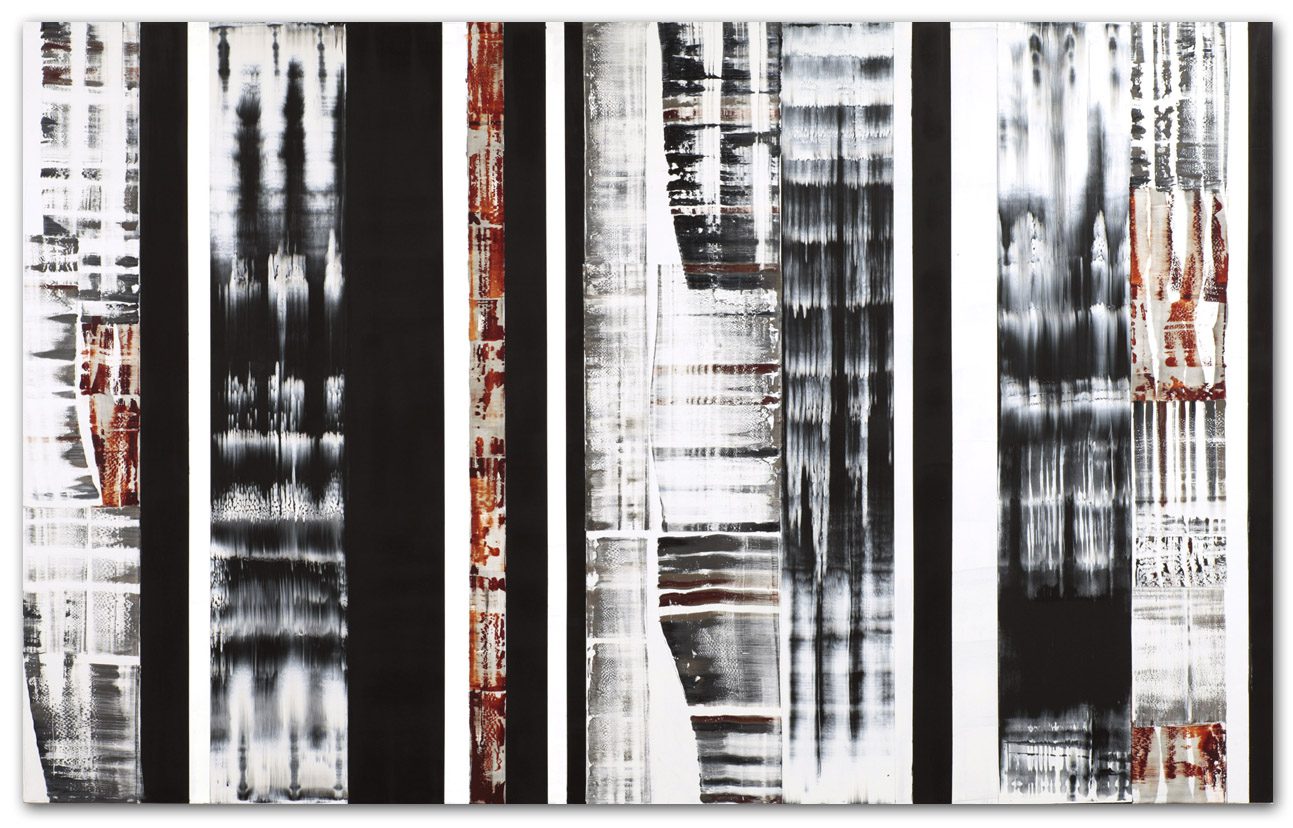
Oil on linen 98.5″ x 157.5″
© Ricardo Mazal
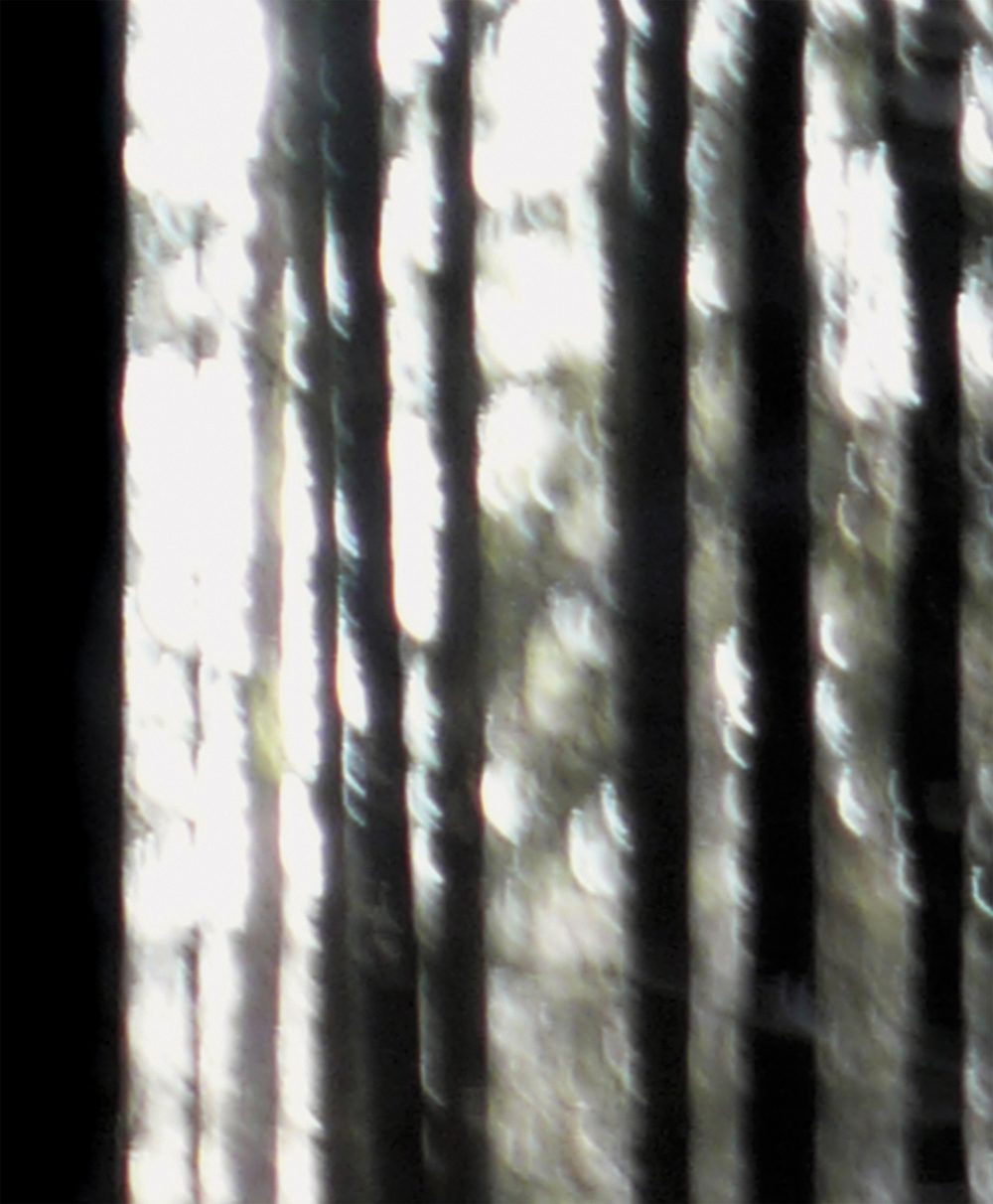
Pigment ink – Print on paper
14″ x 10″
© Ricardo Mazal
After meeting with the mayor to discuss his intention of creating a book about Odenwald, the mayor generously offered to give Mazal his own tree. The next day they left together to search for the right one. Many hours passed without a decision as they walked the forest, during which time Mazal gave great thought to what he was doing. “So who am I? How am I reflecting myself to choose this tree? And I’m by myself, not with my wife or family. I was going through a deep personal analysis” (Bamsey 2009).
Then in the distance, he saw a four-foot-wide tree that opened up into four trunks—two small ones and two large ones—tagged OD 1152. “It was my family and me,” he said, referring to his wife and two children. Mazal then took hundreds of photographs that he turned into digital sketches before doing the final paintings of vertical silhouettes resembling tree trunks.
Part III in the trilogy is entitled Kora, which denotes the pilgrimage around Mount Kailash, the most sacred mountain in Asia.
“With scarce fuel and timber resources and too rocky for digging graves, ‘sky burial,’ or ritual dissection, was once a common funerary practice in Tibet. Now condemned by the Chinese government, it is practiced only on rare occasions. The custom is to dismember the human corpse in specific locations and to place the parts on mountaintops, where they are exposed to the elements and birds of prey” (Dias 2010). Because the majority of Tibetans adhere to Buddhism, Mazal learned that feeding a corpse to vultures is believed to be an essential part of the cycle of life and death. Sky burials are thus not a time for sadness or mourning, but rather a time for reflection on the impermanence of life.
As with The Red Queen and Odenwald projects, the burial ceremony was not the object of Mazal’s focus. Rather, he studied the site itself, and the natural and cultural contexts in which sky burials are practiced. After conducting interviews with local residents, historians, and anthropologists, along with extensive photographic documentation and digital manipulation, the result was a painting that reflected a unique combination of art, nature, and technology. Mazal’s exploration into this ecologically friendly funerary ritual began in 2009 and is now on an exhibition tour.
The completion of this trilogy reflects the theme of Mazal’s work: a celebration of the circle of life. Not only does this trilogy present a unique way to communicate the multilayered and complex subject of death and dying, it does so from a global perspective. Through visual representation of three radically different times and cultures, and the human behaviors and attitudes toward the deceased within that context, he in turn provides us with a powerful way to understand the behaviors and values of the living.
Conclusion

Oil on linen 98.5″ x 125″
© Ricardo Mazal
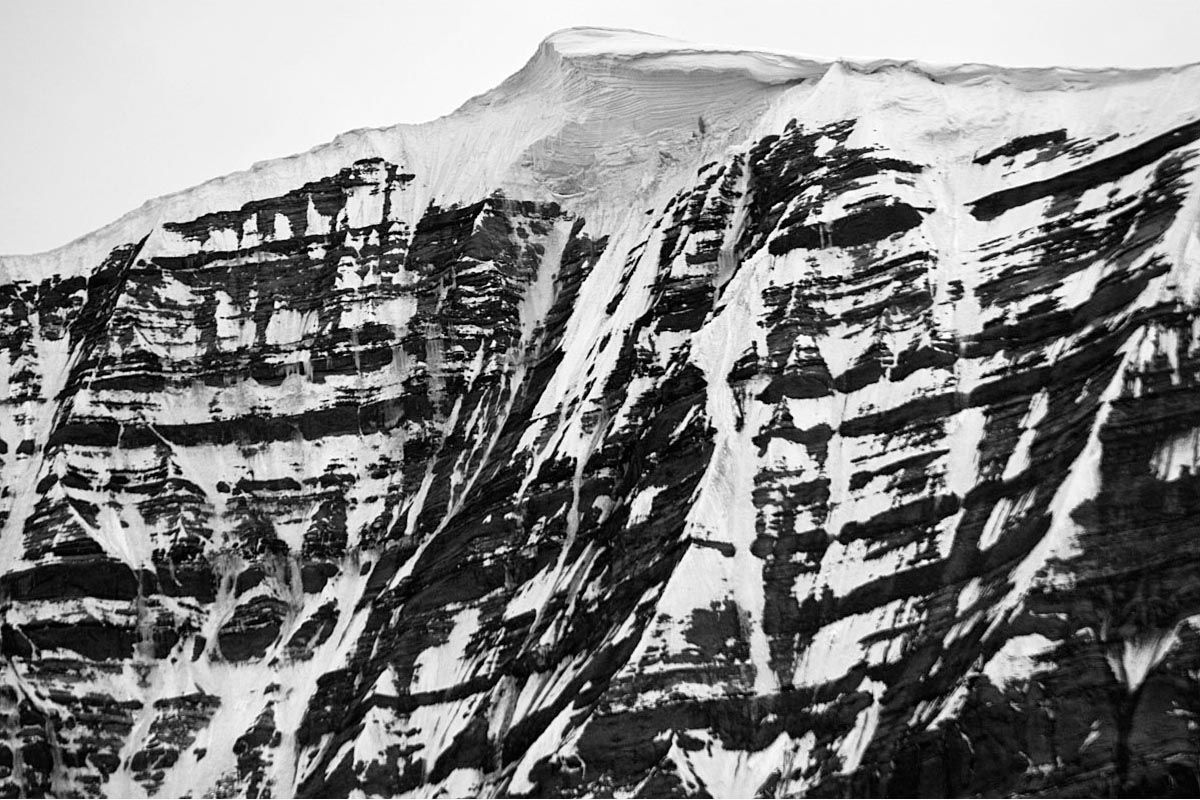
Pigment ink – Print on paper 28.5″ x 43″
© Ricardo Mazal
The space between the known and the unknown, between the reality of life and the abstraction of death, is often one of fear and discomfort, for there is no reference point we can look toward for understanding, no touchstone from which to draw comfort. Through the work of Ricardo Mazal and Joyce Cutler-Shaw, we are given that reference point through a distinct visual language of their own—each providing us with a new way to see, think, and talk about death and dying.
By bridging the gap between the conscious and the unconscious, between interiority and exteriority, maker and viewer, the process of visual representation provides a depth of clarity, understanding, and empathy otherwise difficult to achieve through words alone. Art, in all its forms, is a representation of human experience, and it is in the sharing of our experiences, even as we struggle to make meaning of them, that we create a sense of humanity.
References
- Bamsey, B. 2009. Ricardo Mazal with video interview. Artworks Magazine, Winter 2008.
- Bennett, J. 2005. Empathic vision: affect, trauma, and contemporary art. Stanford: Stanford University Press.
- Cutler-Shaw, J.Genesis of The Anatomy Lesson: The Three Deaths. http://joycecutlershaw.com/anatomy/al_txt.html (accessed February 24, 2010).
- Dias, C. 2010. Ricardo Mazal: A Burial Trilogy. http://www.modavivendi.com (accessed February 25, 2010).
- Morley, S. 2003. Writing on the wall: word and image in modern art. Los Angeles: University of California Press.
- Radley, A. 2009. Works of illness:narrative, picturing and the social response to serious disease. Ashby-de-la-Zouche: InkerMen Press.
- Sontag, S. 2003. Regarding the pain of others. New York: Picador.
MARY T. SHANNON, MSW, MS is a graduate of Columbia University’s master’s program in narrative medicine. Mary has consistently turned to the arts throughout her career for their ability to provide depth, insight, and healing for herself as well as her clients. Author of The Sunday Wishbone: A Memoir, Mary is also an award-winning artist. Founder of Narrative Connections, an online blog and storytelling community, she also conducts “Writing for Your Life” workshops for writers and non-writers alike. Visit her website at www.marytshannon.com.
About the artists
JOYCE CUTLER-SHAW desired to explore the transition from life to death more fully after experiencing the death of her own mother, Lola. She became the first visual artist to be appointed by the School of Medicine of the University of California, San Diego as Artist-In-Residence /Visiting Scholar, where she has worked since 1992. She feels privileged to pursue this independent investigation of the human body in a medical school setting. Drawing is at the heart of her work as a primary language, way of knowing, mode of inquiry, and as an act of empathy. Her works are represented in many museums and library special collections, including the Albertina Museum in Vienna, New York’s Museum of Modern Art and the 42nd Street Library, as well as the Wellcome Institute in London. Permanent installations and her archive is part of the Special Collections Library at the University of California, San Diego. Visit her website at www.joycecutlershaw.com.
RICARDO MAZAL was born in Mexico City and currently lives in New York and Santa Fe, New Mexico. He is represented by galleries in New York, San Francisco, Los Angeles, Vancouver, Mexico, Hong Kong, and Spain. In the last decade, he has had ten individual exhibitions at museums including the Museo de Arte Contemporaneo de Monterrey, Mexico; Museo Nacional de Antropologia, Mexico City; The Americas Society, New York; and The Scottsdale Museum of Contemporary Art. Visit his website at www.ricardomazal.com.
Highlighted in Frontispiece Volume 3, Issue 2 – Spring 2011

Leave a Reply